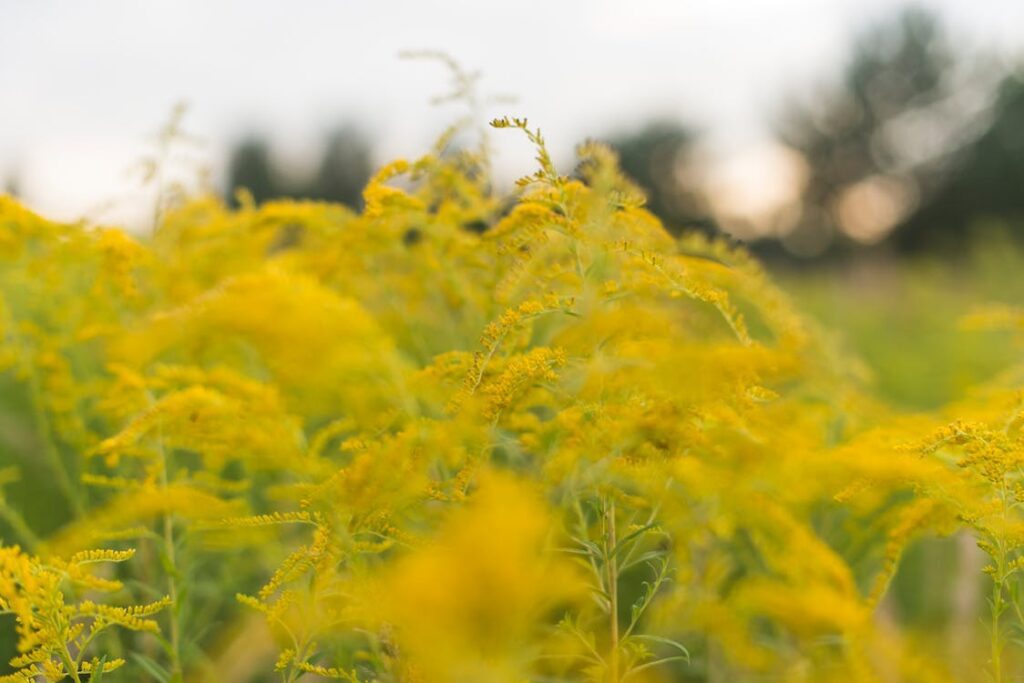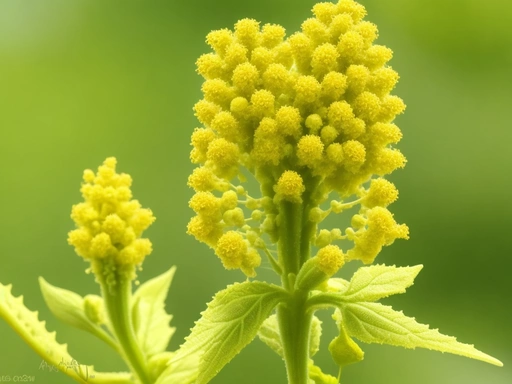You know the feeling of a warm summer breeze, the smell of freshly cut grass, and the sound of birds chirping?
Unfortunately, for some, that summer breeze carries a different smell – one of ragweed. While its pungent odor is unmistakable, do you know what causes it and how it affects the air around us?
Let’s take a look at the powerful and pervasive presence of ragweed – a reminder of the interconnectedness of nature and the importance of belonging.
Key Takeaways
- Ragweed smell is intense and pungent, with an earthy and musty scent.
- The odor strength of ragweed can vary and be faint at times.
- Ragweed smell originates from dry, grassy fields and can cause allergic reactions in sensitive individuals.
- Ragweed pollen released into the air can worsen air quality, leading to respiratory issues and hay fever symptoms.
What Does Ragweed Smell Like
Have you ever wondered what ragweed smells like?
It has an intense odor and typically has an earthy, musty smell.
Ragweed allergies can be triggered by the pollen, which is why it’s important to know what the smell is like.
Odor Intensity
How intensely do ragweeds smell? When it comes to odor intensity, ragweed’s scent can vary depending on the pollen type and air quality. But, there are some common symptoms that many people experience when in contact with ragweed.
Here’s what to look out for:
- Strong, pungent odor
- Variation in scent strength
- Possible allergy symptoms
When ragweed is present, it’s hard to ignore the strong, pungent odor. Depending on the amount of pollen, the scent strength can change. It’s important to be aware of the air quality when ragweed is present, as it can cause a variety of allergy symptoms. When it comes to ragweed, the odor intensity can be strong and cause reactions in those who are sensitive.
Smell Characteristics
You may notice that ragweed has a strong, pungent odor, and can vary in scent strength depending on the amount of pollen present. Its origins are typically considered to be from dry, grassy fields, though the fragrance can also change depending on the air quality. The amount of pollen released and the level of allergies it causes are also factors that can affect the smell.
While the intensity can be quite strong at times, other times it can be quite faint, making it difficult to detect. Various pollen levels can cause different levels of sensitivity in individuals, and it’s important to be aware of the potential impacts of these airborne allergies.
Allergy Impacts
You may notice that ragweed has a pungent odor, and it can cause different levels of sensitivity in individuals. From seasonal allergies to air quality, the pollen count of ragweed can be an allergy trigger for many.
Here are some of the impacts ragweed can have on health:
- Allergic reactions causing respiratory issues
- Hay fever symptoms like sneezing and itchy eyes
- Reduced quality of life due to constant discomfort
Ragweed can be particularly disruptive for those who are highly sensitive to it, leading to long-term health issues. Being proactive is the best way to manage seasonal allergies. Paying attention to the pollen count and taking steps to reduce exposure can help prevent and lessen the impacts of ragweed.

What Causes the Smell of Ragweed
The cause of the distinct smell of ragweed is the pollen it releases into the air. This natural trigger is made up of tiny, airborne particles that are released when pollinating plants are disturbed.
While ragweed is an outdoor irritant, it can also cause indoor allergies if its pollen is brought inside. Allergies are an annoying reality for many, and the smell of ragweed can be a reminder of the discomfort they can bring. The smell of ragweed can be unpleasant and foreign to those who don’t suffer from allergies, and it can be a source of distress for those who do.
Fortunately, there are treatments and methods of prevention that can help keep allergies at bay.
How Ragweed Pollen Affects the Air
Interestingly, ragweed pollen can significantly impact the air quality when it’s released. From seasonal variation to climate change, ragweed pollen can cause some serious issues within our air. Here are some of the effects it can have on the air:
- Allergens released into the air, which can cause respiratory issues
- Heightened sensitivity to irritants that can lead to coughing and sneezing
- Reduced air quality that can cause headaches and congestion
Though climate change can make ragweed pollen season worse, there are some natural and home remedies that can help. Reducing outdoor activities, using an air filter, and taking allergy medications can help reduce the effects of ragweed pollen. Additionally, natural remedies such as steam inhalation or using a neti pot can also help reduce the effects of ragweed pollen.
Though it can be difficult to avoid ragweed pollen, understanding its effects can help us create better strategies to protect ourselves from its effects. Taking proactive steps and staying informed can help us prepare for the seasonal variation of ragweed pollen and reduce the impact it has on our air quality.
How to Identify the Smell of Ragweed
You can easily identify the smell of ragweed as it has a distinct, musty odor. It’s an unpleasant smell that can cause irritation and allergic reactions.
To prevent any exposure to ragweed, it’s important to identify the symptoms and take steps to reduce irritation. One way to do this is to try home remedies or natural solutions. Essential oils such as peppermint or eucalyptus can help reduce the symptoms of ragweed. Taking an antihistamine can also help to reduce the irritation.
If the smell becomes too strong, closing the windows and doors and running an air purifier can help reduce the smell. If you’re still having trouble with the smell of ragweed, consult your doctor for additional solutions.

How to Reduce Ragweed Pollen in the Air
Reducing ragweed pollen in the air can help prevent any allergic reactions or irritation caused by its musty smell. You can take control of the pollen levels by following a few easy steps to minimize their presence.
Here are a few of the best ways to reduce ragweed pollen in the air:
- Implement pollen control methods outdoors: mow the lawn regularly, keep vegetation trimmed, and avoid leaving piles of debris around.
- Invest in air purification systems: air purifiers can help reduce the amount of pollen present in the air inside the home.
- Use nasal sprays: over-the-counter nasal sprays can help reduce the severity of seasonal allergies and their accompanying nasal symptoms.
These are just a few of the ways to reduce ragweed pollen in the air and help prevent any allergic reactions or discomfort caused by its musty smell. Act now to take control of the pollen levels and reduce your risk of irritation.
Health Effects of Ragweed Pollen
Breathing in ragweed pollen can cause a variety of health problems, so it’s important to reduce your exposure to it. During ragweed season, outdoor allergies can spike due to increased allergen levels. Pollen counts are important in this regard, as they measure the amount of pollen grains in the air. The higher the pollen count, the more likely you’re to experience sneezing, coughing, and itchy eyes.
To avoid these symptoms, try to stay indoors when pollen counts are high. If you must go outside, wear a face mask and limit your time outdoors. If you have existing allergies, it’s also helpful to take medication prior to going outside. If you’re unsure of the pollen count, you can always check your local news or weather report.
Taking these steps can help you avoid the uncomfortable effects of ragweed pollen.
Frequently Asked Questions
What Are the Symptoms of a Ragweed Allergy?
If you are experiencing ragweed allergy symptoms such as sneezing, itchy eyes, and a runny nose, consider allergen testing and air purification. Pollen tracking and natural remedies can help reduce environmental impacts and help you feel more in control.
What Other Plants Are in the Same Family as Ragweed?
Recognizing, controlling, and treating ragweed is important, especially if you’re living near it. Identifying it is key; it belongs to the same family as other plants like Asteraceae, Ambrosia, Artemesia, and Xanthium. Knowing these can help you manage your ragweed exposure.
What Is the Most Effective Way to Avoid Ragweed Pollen?
To best avoid ragweed pollen, allergy testing can help identify triggers, while plant identification can help determine seasonal variations. Deterrents usage and avoiding triggers can further reduce exposure, providing long-term relief. Together, these steps can help you create an effective plan for managing ragweed pollen.
How Does the Smell of Ragweed Differ From Other Plants?
You’ll immediately recognize the smell of ragweed – it’s much more pungent than other plants! Its pollen dispersal is powerful, and it can cause seasonal changes and allergy treatments. With a bit of practice, you’ll be able to identify it, and you’ll never feel alone in recognizing odors!
Is Ragweed Pollen Present in All Seasons?
When it comes to treating allergies, ragweed pollen is one of the most common triggers. It’s present in all seasons, but is especially prevalent in late summer and early fall when the weather is warm and dry. Knowing this can help you better prepare and prevent allergies.
Conclusion
Ragweed can be a nuisance for those who suffer from allergies. The smell of ragweed is unmistakable, and can range from musty to pungent.
Taking preventative measures to reduce the amount of ragweed pollen in the air, such as avoiding outdoor activities in the morning and evening, can be beneficial for those who are particularly sensitive.
For example, one man who suffered from severe ragweed allergies found that simply avoiding outdoor activities in the evening hours decreased his allergic reactions significantly.

Experienced writer with 100+ written posts about fragrances and scents
